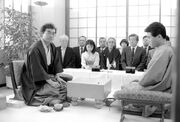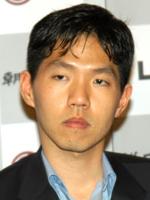Head hurting from all that tsumego'ing and calculating? Take a break and read this brief history on professional Go.
Professional Go began sometime in the early 1900's in Japan. Several organizations popped up before the Nihon Ki-in was created in 1924. Before the Nihon Ki-in and other associations inside and outside of Japan, Go between top players were usually played through castle games. There were several houses of Go players, the most notable being the Honinbo house. Honinbo Dosaku, who was said to have been two stones stronger than any of his peers, and Honinbo Shusaku, who was undefeated in castle games, are generally considered to be the two greatest players of all-time. Both of them made large advancements in the way Go was played.

Go Seigen, the greatest player of the 20th century.
After the Honinbo house era, organized Go began taking shape. The appropiately named Go Seigen was brought to Japan by Segoe Kensaku, who was also responsible for Hashimoto Utaro (founder of the Kansai Ki-in) and Cho Hunhyun (considered to be Korea's best player ever). Go went on to revolutionize the game along with Kitani Minoru. Like Shusaku, Go Seigen had an almost impeccable record in jubango games (ten game series') and is universally considered the greatest Go player of the 20th century, if not all-time.
Kitani later went on to found the Kitani Go Dojo, which produced the "Golden Generation" of Japanese Go players. Among Kitani's pupils were Otake Hideo (Honorary Gosei), Kato Masao (Honorary Oza, the most feared player in Japanese Go), Ishida Yoshio (24th Honinbo), Takemiya Masaki (notable for his "Cosmic" style which favored the center over the corners), Kobayashi Koichi (Honorary Kisei, Meijin and Gosei) and last but not least, Cho Chikun (the most successful Japanese player with 71 titles).

A Honinbo title match between Takemiya Masaki (L) and Otake Hideo (R). The finals for the Honinbo are played over two days.
The first Go tournament was named after the Honinbo house. Takagawa Kaku won the title nine straight times from 1952 to 1960. He finally lost the title to Sakata Eio, who then held it for six straight years. These two made up the "three crows" of the 50s and 60s along with Fujisawa Hosai, the first ever 9 dan. Later on, perhaps the strongest Japanese player of post-Seigen era, Fujisawa Hideyuki took over, winning the newly-created Kisei six times in a row. Fujisawa Hideyuki went on to teach Cho Hunhyun and Nie Weiping and is generally thought to be the spark that ignited China and Korea's overtaking of the Go world.
The professional Go scene was mostly dominated by Japan up until the 80s. By then, the Korean Baduk Association (KBA) could only produce a handful of players to challenge the strong Japanese wave. China at the time didn't even have a professional organization. However, Japan's grip over the Go world slowly loosened as players such as Nie Weiping and Ma Xiaochun began defeating top Japanese pros in the China-Japan Supermatches. Then Cho Hunhyun won the first Ing Cup as the only Korean representative.

A game between Cho Hunhyun and Ishida Yoshio.
Although Japan were still strong in the late 80s and early 90s, a new wave of professionals from China and Korea proved to be too strong for Japan's aging stars. Lee Changho, along with teacher Cho Hunhyun, were the leaders of Korea during their meteoric rise to the top. Changho is considered to be the strongest player of the 90s, having won 18 international titles. Meanwhile, China produced the likes of Chang Hao and later Gu Li. The two have combined for 9 international titles.
The latest Korean wave is the strongest in professional Go history, consisting of players such as Lee Sedol, Choi Cheol-han, Pak Yeong-hun, Kang Dongyun and Mok Jin-seok. At one point, Korea had won 55 straight international titles.
Lately, Japan has fallen to the wayside while China and Korea have become stronger. For comparison reasons, in Japan, most insei still take two stone handicaps from 9 dan professionals while in Korea, most insei can beat 9 dan professionals in even games. In fact, in the current Agon Cup, two Korean amateurs qualified for the tournament by beating two Japanese professionals each - one of the losers was former Japan number one Cho Chikun.

Lee Changho, the strongest player of the 90s and 00s.
Like any other sport, fans and hobbyists tend to idolize their "heroes". My favorite player is Kato Masao, a player so fierce that he once forced the 22nd Honinbo Takagawa Shukaku to resign after just 93 moves. Who's yours? Not sure who you like? Here's a list of players with their styles. Once you reach the high kyus, it's good to review professional games, so once you do, select one or three of those pros and study their games and fit their styles in to your Go.